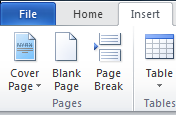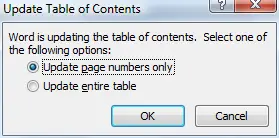How to create a Table of Contents in Word
This lesson shows you how to create a Table of Contents (TOC) in Microsoft Word. It takes you through the two-step process of creating a table of contents in your document, and also shows you how to automatically update the TOC to reflect the content in your document as it changes. A table of contents works particularly well in long documents because they help your readers to navigate your document more easily.
Creating a Table of Contents - Overview
A table of contents lists the headings and subheadings in your Word document and provides a page number reference for each heading. You can control which headings appear in the table of contents. The table of contents traditionally appears near the start of the document, although Word allows you to place it anywhere you like in your document.
If someone is reading your document in Microsoft Word, they will be able to click the page numbers in the table of contents to jump straight to that section of the document. This also works if you create a PDF from your document (creating a PDF in a Word document is covered in Create a PDF from Word, Excel, PowerPoint or any Microsoft Office document).
There are three steps involved in creating a table of contents from Microsoft Word:
- Create your document using heading styles to identify the headings that should appear in the table of contents.
- Insert a table of contents (skip to this section).
- Update your table of contents when the content of your document changes (skip to this section).
If you're using Word 2011 for Mac, click here to view the lesson on creating a table of contents in Microsoft Word 2011 for Mac.
Step 1 - Assign Heading Styles to your document
Microsoft Word provides a feature called Styles as a way to format and structure a document in a consistent way. They also make it easy to reformat your document, since changes to the style definitions are automatically applied to all content to which those styles have been applied. The most common styles are Heading 1, Heading 2 and Heading 3, although Word offers a style sheet of dozens of different styles for different purposes.
Styles are important to us because they can also be used to create your table of contents. In this lesson we'll look at how to use Styles but not how to create, edit or manage them.
Using Styles in Microsoft Word is easy thanks to the Quick Styles Gallery, which is found in the Home toolbar:

To apply a style, simply select the text to which you want to apply a style, and then click the appropriate style in the Quick Styles Gallery.
By default, Microsoft Word builds the table of contents using any text in your document that has Heading 1, Heading 2 or Heading 3 applied to it (although you can change this, and add other styles to the TOC if you want). You'll notice from the picture above that the Quick Styles Gallery doesn't have a button for the Heading 3 style. Don't worry - we'll look at how to apply a Heading 3 style later in the lesson.
Here's an example of a document with some content that we will format using Word's built-in styles. I've identified the styles that I plan to assign to each paragraph:
Here's the same document after it has been formatted using styles for Heading 1 and Heading 2 from the Quick Styles toolbar:
Given that the Heading 3 style is not available in the Quick Styles Gallery by default, you can follow these steps to apply Heading 3 if you need it (there are other ways to do it, but this way is quick, easy, and will result in a Heading 3 button being added to the Quick Styles Gallery). If you don't plan to use Heading 3 styles in your documents you can skip this section.
- Select a paragraph to which you want to apply the Heading 3 style.
- By the way, here's a useful trick to select several headings at once. Float the mouse to the left of the first heading you want to select, and click. That should select the whole heading. Then, float your mouse to the left of the next heading, then press CTRL and press click. The first heading will stay selected, and the second heading will also be selected - without selecting the text in between those headings.
- Expand the Quick Styles Gallery by clicking the button highlighted in yellow below:
- In the expanded Quick Styles Gallery, click the option to Apply Styles (you'll see it right at the bottom):
- When the Apply Styles dialog appears (see below), click the drop-down to expand the list of styles:
- You can then click Heading 3 in the list as shown above and the Heading 3 style will be applied to the selected text.
- There are several points worth noting at this point:
- Note that if you don't see Heading 3 in the list, you can simply type Heading 3 in place of the word Normal.
- There's no need to click OK or Reapply once you have chosen or typed Heading 3 - it will be applied automatically to the selected paragraph.
- The Heading 3 button will be added to the Quick Styles Gallery automatically so you can use it again later in your document.
Our document now looks like this:
Now that we have a document that contains content formatted using Word's heading styles, we can create our Table of Contents.
Step 2 - Insert a Table of Contents
To insert a table of contents into your document, follow these steps:
- Select the position in the document where you want the table of contents by clicking in the point of the document where the table of contents should be inserted.
- Choose the References ribbon toolbar as shown here:
- Click the Table of Contents button - you'll see a list of pre-formatting Table of Contents styles to choose from:
- You can then choose from four Table of Contents options shown.
- You can choose either of the built-in Automatic Tables as a starting point - you will be able to customize the formatting of the ToC once you've inserted it.
- You can select a table of contents style from Office.com (we won't explore this option here).
- You can Insert Table of Contents (this lets you customise your table of contents before inserting it.
- Yu can create a Manual Table. If you want a table of contents that will update when your document changes, you should ignore this option. This option requires you to manually create the entries in your table of contents and is not linked dynamically to the content in your document. If you choose this option you'll need to manually update it every time your document changes.
- For this lesson, let's choose Automatic Table 2. This will insert a table of contents at the point you selected earlier. As you'll see in the picture below, the title, Table of Contents has been inserted automatically. Each of the headings from our sample document been used to create the table of contents:

- You may notice in the example above that the table of contents has been inserted on the same page as the text used to create it. As a result, the page numbers in the table of contents are all 1, which is the same page that the content is on.
- It's likely you will want to put the TOC on a separate page. You can do this by inserting a page break after the table of contents:
- Click at the start of at the first heading (this is where the page break will be inserted, and then either press CTRL+Enter on the keyboard, or click the Insert tab on the ribbon toolbar and then click the Page Break button:

- Click at the start of at the first heading (this is where the page break will be inserted, and then either press CTRL+Enter on the keyboard, or click the Insert tab on the ribbon toolbar and then click the Page Break button:
- Next, you will need to update the table of contents to reflect the new page numbers (our document is now on page 2, not page 1).
Step 3 - Update your table of contents to reflect changes in your document
- Any time you update your document with new headings or content, you should update the table of contents to reflect the changes to the page numbering that have taken place.
- There are several ways you can update your table of contents - you can choose your favorite from this list:
- If you click inside the table of contents, you will see an option to Update Table. This method is fast, but requires that you find and select your table of contents - this can be time consuming in a large document:
- You can right-click the table and choose Update Field from the context menu that appears. This method also requires that you find and select your ToC:
- There is an Update Table button on the References toolbar. This works wherever you are in the document regardless of whether the table of contents is selected:
- Finally, this method is my favorite. Word will automatically update your table of contents when you print your document. Therefore, you can update your table of contents by presing CTRL+P on the keyboard to view the print dialog screen, then press ESC to cancel printing and return to your document. After this, your Table of Contents will be updated
- If you click inside the table of contents, you will see an option to Update Table. This method is fast, but requires that you find and select your table of contents - this can be time consuming in a large document:
- Whichever option you choose for updating your table of contents, the following dialog box will appear:

- Update page numbers only will update the page numbers in your table of contents but will not add any new headings you may have added to your document. Update entire table will update both page numbers and include all new headings in the table of contents.
Join our mailing list
Our Comment Policy.
We welcome your comments and questions about this lesson. We don't welcome spam. Our readers get a lot of value out of the comments and answers on our lessons and spam hurts that experience. Our spam filter is pretty good at stopping bots from posting spam, and our admins are quick to delete spam that does get through. We know that bots don't read messages like this, but there are people out there who manually post spam. I repeat - we delete all spam, and if we see repeated posts from a given IP address, we'll block the IP address. So don't waste your time, or ours. One other point to note - if you post a link in your comment, it will automatically be deleted.












Add comment